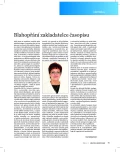Physical restraints: the principles and standards for their use.
Authors:
M. Lukasová
Published in:
Geriatrie a Gerontologie 2016, 5, č. 3: 154-158
Category:
Review Article
Overview
The article aims to explain the legal differences between various methods of administering care, which result in restrictions to the patient’s free movement, focusing on the use of force for management of problematic behaviour. This requires explicit legal grounding, which is conceptualised in the Healthcare Act as the institute of restraining measures. This summarises the basic legal principles and rules for the use of physical restraints and represents the corresponding part of the European Council Standards for prevention of torture and inhumane or degrading treatment. Using the example of sideboards, it demonstrates the principle of proportionality when enacting measures, which limit the person’s free movement.
KEYWORDS:
physical restraint – problematic behaviour – CPT standards – patient’s rights – use of force - sideboards
Sources
1. European Committee for the Prevention of Torture and Inhuman or Degrading Treatment or Punishment. CPT Standards. „Substantive“ sections of the CPT’s General Reports [online]. Strasbourg: Council of Europe, 2002, rev. 2015 [cit. 18. 7. 2016]. Dostupné z: http://www.cpt.coe.int/en/docsstandards.htm
2. Lukasová M. Recenze anglické směrnice o omezovacích prostředcích. Geri a Gero 2015; 2: 92–98.
3. Department of Health. Positive and Proactive Care: reducing the need for restrictive interventions [online]. London: Social Care, Local Government and Care Partnership Directorate, 2014 [cit. 18. 7. 2016]. Dostupné z: https://www.gov.uk/government/publications/positive-and-proactive-care-reducing-restrictive-interventions
4. Department of Health. Mental Health Act 1983: Code of Practice. London TSO; 2015. Dostupné z: https://www.gov.uk/government/publications/code-of-practice-mental-health-act-1983, [cit. 18. 7. 2016].
5. Alzheimer Europe. Doporučení k použití omezovacích prostředků v péči o seniory s demencí. In: Madridský plán a jiné strategické dokumenty. Praha: Gerontologické centrum 2007; 101–106.
6. Vláda České republiky. Vyjádření vlády České republiky ke Zprávě o návštěvě České republiky, kterou vykonal Evropský výbor pro zabránění mučení a nelidskému či ponižujícímu zacházení nebo trestání (CPT) ve dnech 1. až 10. dubna 2014 [online]. Štrasburk: Rada Evropy, 2015 [cit. 18. 7. 2016], vyjádření k odstavci 166. Dostupné z: http://www.cpt.coe.int/en/states/cze.htm. Rovněž jako příloha Usnesení vlády České republiky ze dne 29. července 2015 č. 609
7. Evropský výbor pro zabránění mučení a nelidskému či ponižujícímu zacházení nebo trestání. Standardy CPT, „Podstatné“ části obecných zpráv CPT [online]. Štrasburk: Rada Evropy 2016. [cit. 18. 7. 2016]. Dostupné z: http://www.cpt.coe.int/czech.htm
8. Veřejný ochránce práv. Domovy pro seniory a domovy se zvláštním režimem. Zpráva ze systematických návštěv veřejného ochránce práv[online]. Brno: Veřejný ochránce práv 2015. [cit. 18. 7. 2016]. Dostupné z: http://www.ochrance.cz/ochrana-osob-omezenych-na-svobode/
Labels
Geriatrics General practitioner for adults Orthopaedic prostheticsArticle was published in
Geriatrics and Gerontology

2016 Issue 3
- Memantine Eases Daily Life for Patients and Caregivers
- Advances in the Treatment of Myasthenia Gravis on the Horizon
- Metamizole vs. Tramadol in Postoperative Analgesia
- Metamizole at a Glance and in Practice – Effective Non-Opioid Analgesic for All Ages
- Memantine in Dementia Therapy – Current Findings and Possible Future Applications
Most read in this issue
- Physical restraints: the principles and standards for their use.
- Nutritional screening carried out by nurses in retriement homes.
- Integrated care: starting points and theoretical limitations of the koncept.
- The institute of formerly expressed wishes in Czech healthcare
